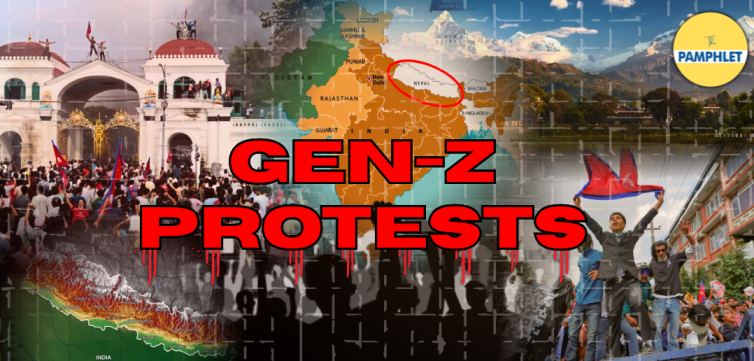Pegged as the most unserious generation in history, Gen Z orchestrated a political upheaval in Nepal in a manner never seen before. As the parliament was engulfed in flames, they danced on reels, chanted slogans infused with memes, and played ‘Ludo’ while prisoners escaped from jails nationwide. These were the ‘GenZ Protests’ of Nepal, a unique spectacle from a generation that is not just unprecedented but also the first truly digital-native generation, a generation that many of us can relate to.
This ‘being relatable’ is the USP and actual intention behind such protests, if you look at it broadly. The spectacle amused netizens across the world—TikTok dances and Discord polls replaced traditional politics, hashtags louder than manifestos, and memes more powerful than institutions.
But behind the absurdity lies a dangerous pattern: youth anger turned into political chaos, digital tools converted into weapons of regime change.
This is why the word “Gen Z” matters here. Unlike previous generations, Gen Z doesn’t protest with pamphlets, manifestos, or trade unions. They protest with reels, hashtags, and Discord polls. Their digital-native identity makes them both powerful and vulnerable, and easily mobilized, but also easily manipulated. Which is why every time a government in South Asia collapses with students and youth at the frontlines, we need to ask: is this authentic people’s power, or just another chapter from a global playbook, a set of strategies and tactics used by external players to influence and manipulate such protests?
Nepal: What happened during the world’s first ‘GenZ Protest’?
September 2025: Kathmandu went up in flames. What began as a protest against corruption and a proposed social media ban, which was seen as an attempt by the government to suppress free speech, turned into full-blown chaos. However, it’s important to note that the foreign companies failed to meet a deadline to comply with local registration requirements, which added fuel to the fire.
Parliament was torched, 51 people died, banks were looted, and 12500 prisoners walked free as the jails were stormed. Within days, Prime Minister K.P. Sharma Oli was forced to resign, and the former chief justice of Nepal took over as the interim Prime Minister.
On the surface, it looked like Gen Z had finally woken up, and a young generation that was long accused of apathy was suddenly out on the streets, fighting for rights. But the question remains: did they truly win, or were they simply used as pawns in a much larger game?
Social media a boon for such protests
Gen Z, being a digitally native generation, leverages social media for every stage of their protests, from ideation to execution. In these moments, social media emerges as the great equalizer of politics, breaking down barriers of geography, resources, and hierarchy, and giving the ordinary citizen the same platform as a minister.
Nepal isn’t the only country to see a regime change, which was started on social media. Let us break it into sections:
- Arab Spring (Tunisia, 2011): What began with a fruit vendor’s protest spread like wildfire through Facebook and Twitter (now X). The digital sphere helped youth mobilize at unprecedented speed, bringing down authoritarian regimes that had ruled for decades. Tunisia became the textbook case of ‘Facebook Revolution.’
- Kenya(2024): Hashtags like #OccupyParliament rallied youth against corruption. Online organizing spilled onto the streets, forcing accountability from political elites who thought they were untouchable.
- Nepal (2025): Despite the chaos that followed, the initial mobilization showed the sheer force of Gen Z digital networks. Within hours, VPNs and hashtags bypassed government censorship, flooding the streets with thousands of young protestors.
In these moments, social media was not just a tool; it was the bloodstream of protest, a space where anger became community, and community became a political force.
Social media, a bane for the generation
However, every tool has its drawbacks. The paradox is that the same social media that empowers also has the potential to destabilize, distort, and destroy.
- Arab Spring Failures: Egypt, Libya, and Syria witnessed uprisings fueled by social media, but without structure or leadership. Regimes fell, only to be replaced by chaos, civil wars, and even more authoritarian rulers.
- Bangladesh (2024): What initially began as a student agitation against the quota system spiraled into violence. The Supreme Court of Bangladesh took back every decision made by Sheikh Hasina, yet broadcasters were torched, police stations attacked, women were raped, and temples were destroyed. The movement never stopped, exposing its hijack by external players. Sheikh Hasina was forced to leave the country, and Nobel laureate Muhammad Yunus, long cultivated by Western networks, was suddenly installed as interim head.
- Pakistan (2022-24): Social media became the battlefield of ‘Important Hukumat’ slogans. Gen Z, radicalized through TikTok and Twitter, stormed military compounds and torched institutions, an outrage that looked spontaneous but was steered by hidden hands.
Every protest that begins with genuine student or Gen Z anger does not necessarily end with justice. Time and again, we see that often external players orchestrate such movements, and those that aren’t orchestrated are frequently hijacked. Youth are placed at the front as the moral face, while the real steering wheel lies elsewhere.
Here, social media plays a crucial role in accelerating this process: hashtags are crafted to globalize the grievance, memes turn complex politics into oversimplified binaries, and influencers convert rage into spectacle. In this way, what starts as a fight against corruption or injustice is quietly reframed into a struggle for regime change, often aligned with foreign strategic interests. But the playbook doesn’t stop at the streets; it seeps into everyday culture.
The Indian context: Manufacturing a Gen Z ‘Revolution’
If Nepal burned with hashtags and Bangladesh collapsed under student marches, India has seen repeated attempts to copy-paste the same playbook. From the CAA–NRC protests to the farmers’ agitation, student campuses and youth influencers were mobilized as the face of “people’s resistance.” Even today, self-proclaimed left-leaning influencers like Shamita Yadav, aka Ranting Gola and Medusa, are trying to create chaos just like Nepal in India.
Slogans like “Azadi” were romanticized, international media framed these movements as “India’s youth against discrimination,” and social media campaigns gave the impression of a generational uprising. But peel back the layers, and the same toolkit becomes visible: create a trigger issue, amplify it through memes and influencers, manufacture international outrage, and hope the chaos snowballs into political collapse.
Beyond protests, the subtler game is the soft conversion of Gen Z minds. Unlike the street movements of our neighbors, in India, much of the battle is fought on screens. Instagram reels, YouTube shorts, podcasts, and meme pages constantly drip-feed a new narrative: that “real dissent” is fashionable, that opposing the state is cool, and that specific political figures represent the “authentic voice of youth.” The most striking example of this rebranding is Rahul Gandhi. No longer projected as the heir of a political dynasty, he is carefully repackaged as a relatable “Gen Z leader”—in sneakers, t-shirts, podcasts, and Instagram reels. Less policy, more personality. Less ideology, more relatability. For a generation scrolling endlessly, this is not politics but lifestyle branding.
And this is where India differs. Our institutions, from courts to election bodies, have so far resisted a full-blown hijack. The public has also shown a sharper instinct to see through borrowed slogans and imported scripts. Yet, the attempts continue—because in the global playbook of regime change, a restless Gen Z is the most valuable raw material.
So what can be done?
Social media doesn’t distinguish between authentic dissent and engineered chaos, between genuine anger and manufactured outrage. And when youth energy is hijacked, the outcome is rarely reform—it is usually instability, exploitation, and foreign interests moving into the vacuum.
“With great power comes great responsibility.” For Gen Z, this means learning to see through the scripts written for them. It means questioning why every protest, no matter how genuine at the start, ends up serving someone else’s agenda. And most importantly, it means grounding activism not in fleeting trends but in historical memory and civic understanding.
So what can be done? We must narrate history in a language Gen Z understands. If they live in memes, reels, and shorts, then history and politics must be retold in the same format. If they scroll endlessly, then they must also scroll into India’s long struggles, civilizational roots, and the lessons of nations that collapsed under the same playbook. Because a generation that knows only slogans will remain pawns, but a generation that knows history will not be easily manipulated.
India today stands at a crossroads. This formula has already been tested in Nepal, Bangladesh, Pakistan, and Sri Lanka. Whether India becomes the next experiment or the exception will depend on how Gen Z wields its digital power—recklessly as fuel for others’ agendas, or responsibly as guardians of their own nation’s destiny.
In a world of borrowed slogans, India’s youth must decide whether to be pawns or pioneers.









